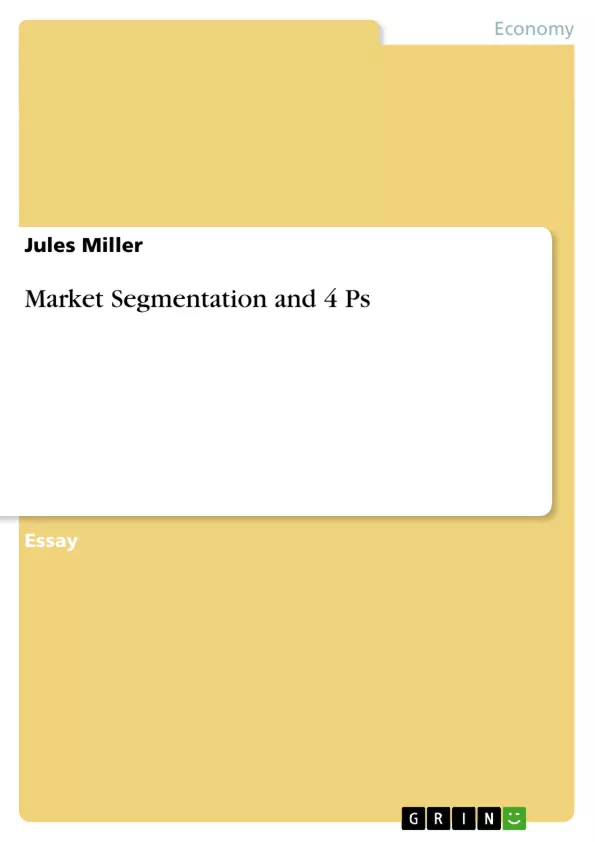Market segmentation allows an enterprise to identify the race-the segment-it can win with its car. Once a segmented to be targeted has been identified, appropriate configuration of the offer through the marketing mix will help the company gain the marketing advantage with the right product at the right place and promoted in the right way. As markets are not static but dynamic, competitiveness relies also on the capability of the company to be alert to changes affecting the target segment in order to adapt the 4Ps accordingly and at the same time to ensure production differentiation.
Inhaltsverzeichnis (Table of Contents)
- Introduction
- Market segmentation
- Market Segmentation and 4 Ps
- Marketing mix and marketing competitive advantage
- Product
- Price
Zielsetzung und Themenschwerpunkte (Objectives and Key Themes)
This essay aims to explain market segmentation and analyze the importance of the 4Ps (product, price, place, and promotion) in achieving a competitive advantage through providing consumers with more valuable products or services.
- Market segmentation as a tool for targeting specific consumer groups
- The role of the 4Ps in building a successful marketing mix
- The importance of product differentiation in achieving a competitive advantage
- The interplay between price, value, and customer perception
- The impact of market research on effective segmentation and marketing strategy
Zusammenfassung der Kapitel (Chapter Summaries)
The introduction outlines the essay's purpose and the importance of gaining a marketing advantage in a competitive environment. It introduces the concept of market segmentation and the significance of the 4Ps in achieving this advantage.
The chapter on market segmentation defines the concept and explores how to divide a market into smaller, homogeneous groups. It discusses the use of data based on customer, user, organizational, and market characteristics for both B2C and B2B markets. The chapter emphasizes the economic reality of limited resources and the need for targeted offerings to specific segments. It explains how market segmentation aids in ensuring that the marketing mix elements are aligned with the needs of specific customer groups.
The chapter "Market Segmentation and 4 Ps" explores the concept of optimal segment size and emphasizes the importance of meeting customer needs better than competitors. It highlights the potential for innovation when addressing unmet needs and stresses the benefits of minimizing competition. The chapter uses the example of a car dealership in Rwanda to illustrate the application of market segmentation in practice.
The section on "Marketing mix and marketing competitive advantage" introduces the 4Ps as fundamental elements of the marketing mix. It emphasizes the role of product differentiation in achieving a competitive edge. Using the Rwandan car dealership example, it further explains how the company can differentiate its offering by providing additional services like warranties, insurance, and maintenance, to attract the target segment.
The essay's section on "Product" elaborates on the importance of understanding the target segment and competitors to effectively develop and offer products or services that match their needs and purchase habits. It emphasizes the role of market research in building product differentiation and achieving a competitive advantage.
The "Price" section discusses the importance of strategic pricing and emphasizes the need to consider the customer's perspective and the value proposition. It mentions various pricing methods, highlighting the cost-plus method often employed by SMEs and its potential drawbacks.
Schlüsselwörter (Keywords)
Market segmentation, 4Ps, competitive advantage, product differentiation, pricing strategy, market research, B2C, B2B, target segment, value proposition.
- Quote paper
- Masters of Arts (Marketing) Jules Miller (Author), 2011, Market Segmentation and 4 Ps, Munich, GRIN Verlag, https://www.grin.com/document/180606



